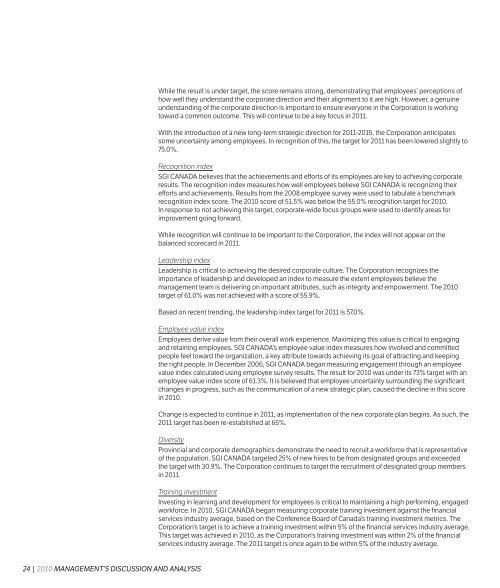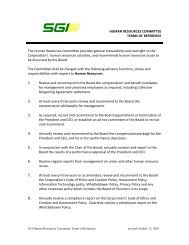Full report - SGI Canada
Full report - SGI Canada
Full report - SGI Canada
Create successful ePaper yourself
Turn your PDF publications into a flip-book with our unique Google optimized e-Paper software.
Auto Fund constructive obligation<br />
The Corporation allocates a portion of its retirement benefit costs associated with its defined benefit<br />
pension plan and defined benefit service recognition plans to the Saskatchewan Auto Fund for those<br />
employees of the Corporation who provide service to it. The employee benefit adjustments made under<br />
IFRS above result in the Auto Fund having a constructive obligation to the Corporation. The constructive<br />
obligation arises from events and transactions before the date of transition to IFRS, and accordingly has<br />
been recognized directly in retained earnings. The impact on retained earnings at January 1, 2010, of this<br />
constructive obligation is an increase to retained earnings of $5,868,000.<br />
Property, plant and equipment<br />
The Corporation plans to utilize the IFRS 1 election to measure its land and building as of the date of<br />
transition to IFRS at its fair value, and use that fair value as its deemed cost on a go-forward basis. The use<br />
of this exemption results in an increase to retained earnings at January 1, 2010, of $23,225,000.<br />
Financial instruments<br />
The Corporation plans to utilize the IFRS 1 election that allows it to change the designation of its financial<br />
instruments upon transition to IFRS. Upon transition, all investments are planned to be designated as fair<br />
value through profit and loss rather than their current designation as available for sale. This will result in<br />
changes in unrealized gains and losses on investments being recognized in the statement of operations,<br />
rather than through other comprehensive income. This accounting policy change results in an increase to<br />
retained earnings of $19,833,000 and an offsetting decrease to accumulated other comprehensive income<br />
at January 1, 2010.<br />
Insurance contracts<br />
The Corporation plans to utilize the IFRS 1 exemption, which allows the Corporation to disclose only five<br />
years of data in its loss development tables, consistent with the transitional provision of IFRS 4, Insurance<br />
Contracts. The disclosure will be increased in each subsequent year, until a full 10 years of information<br />
is included.<br />
Under Canadian GAAP, the Corporation does not discount its provision for unpaid claims for all lines of<br />
business. In transitioning to IFRS, the Corporation is changing this policy to discount the provision for<br />
unpaid claims and the associated unpaid claims recoverable from reinsurers for all lines of business. At<br />
January 1, 2010, the impact to retained earnings of adopting full discounting is an increase to retained<br />
earnings of $7,475,000.<br />
Business combinations<br />
The Corporation plans to utilize the IFRS 1 exemption, which allows the Corporation the option to apply<br />
IFRS 3, Business Combinations, prospectively from the transition date. If this exemption was not used,<br />
IFRS would require the restatement of all business combinations that occurred prior to the transition date.<br />
As such, business combinations have not been restated. As a result of applying this exemption, goodwill<br />
and non-controlling interest arising on business combinations prior to the transition date have not been<br />
adjusted from the carrying value previously determined under Canadian GAAP.<br />
Leases<br />
The Corporation plans to utilize the IFRS 1 exemption with regards to determining if an arrangement<br />
contains a lease. This exemption eliminates the requirement for the Corporation to re-assess the<br />
determination of whether an arrangement contains a lease at the date of transition if the conclusion<br />
reached under Canadian GAAP is the same as the conclusion that would have been reached under IFRS.<br />
Related Party Transactions<br />
The Corporation is related in terms of common ownership to all Government of Saskatchewan ministries,<br />
agencies, boards, commissions, Crown corporations and jointly controlled and significantly influenced<br />
corporations and enterprises. Transactions with these entities were entered into in the normal course of<br />
business and are settled at prevailing market prices under normal trade terms. Further details regarding<br />
these related party transactions are disclosed in note 17 of the consolidated financial statements. Details of<br />
other significant related party transactions disclosed in the consolidated financial statements follow.<br />
<strong>SGI</strong> is the administrator of the Saskatchewan Auto Fund on behalf of the Province of Saskatchewan.<br />
<strong>SGI</strong> CANADA incurs administrative and claim adjustment expenses on behalf of the Auto Fund, which are<br />
charged to the Auto Fund. Amounts incurred by <strong>SGI</strong> CANADA and charged to the Auto Fund were<br />
$119.1 million (2009 – $112.4 million).<br />
The Corporation, as the lessor, has an interest in a capital lease in Prince Albert, Saskatchewan, with the<br />
Ministry of Government Services, a provincial government ministry. This lease expires in April 2011. Further<br />
details of this lease are provided in note 7 to the consolidated financial statements.<br />
The Corporation had direct premiums that were brokered through Charlie Cooke Insurance Agency Ltd.<br />
(CCIA), pays loss adjustment fees to Atlantic Adjusting & Appraisals Ltd. (AAA) and had premiums<br />
financed for policyholders by Maritime Finance & Acceptance Corporation (MFAC). These companies<br />
are affiliated with the minority shareholder of ICPEI, who is a member of ICPEI’s senior management. The<br />
policies written and the loss adjustment expenses paid are routine operating transactions in the normal<br />
course of business. Details of the transactions and amounts outstanding are included in note 17 to the<br />
consolidated financial statements.<br />
On June 1, 2010, the Corporation, through its subsidiary, ICPEI, loaned the primary shareholders of<br />
CCIA $1,146,000 (two loans of $605,000 and $541,000 with consistent terms and conditions) in order to<br />
fund their purchase of the Corporation’s minority interest in CCIA (note 5). Subsequent to the sale, the<br />
Corporation and CCIA are no longer related. The loans require 10 equal annual payments of $128,790,<br />
including principal and interest, beginning on March 31, 2011. The loans accrue interest at an effective<br />
annual rate of 2.25% and are secured by a general security agreement covering all assets of CCIA.<br />
On December 22, 2010, the Corporation, through its subsidiary, <strong>SGI</strong> CANADA Insurance Services Ltd.,<br />
loaned the purchaser of MFAC and AAA $343,000 (two loans of $181,000 and $162,000 with consistent<br />
terms and conditions) in order to fund their purchase of the MFAC and AAA shares (note 5). The loans<br />
require seven equal annual payments of $57,000 including principal and interest, beginning on<br />
March 31, 2011. The loans accrue interest at an effective annual rate of 4.00% and are secured by a<br />
general security agreement covering all assets of MFAC and AAA, and guarantees from the purchaser.<br />
In 2007, the Corporation provided CCIA a $450,000 loan for the purpose of purchasing a brokerage. The<br />
terms of the agreement provide for repayment in six annual instalments of $75,000 and require CCIA to<br />
maintain minimum premium limits. At December 31, 2010, the loan is recorded at its amortized cost of<br />
$206,000 (2009 – $268,000), calculated by discounting the scheduled instalments at an interest rate that<br />
reflects the term and credit risk associated with the loan. During the year, $75,000 (2009 – $75,000) was<br />
repaid and interest revenue of $13,000 (2009 – $17,000) was recorded through investment earnings.<br />
One Board member owns an organization that sells insurance policies of the Corporation. Premiums<br />
written during the year from this organization amounted to $4.4 million (2009 – $4.4 million) and the<br />
associated accounts receivable at December 31, 2010, was $775,000 (2009 – $887,000). Commissions<br />
related to these premiums were $824,000 (2009 – $792,000). The above noted transactions are routine<br />
operating transactions in the normal course of business.<br />
48 | 2010 MANAGEMENT’S DISCUSSION AND ANALYSIS MANAGEMENT’S DISCUSSION AND ANALYSIS 2010 | 49















